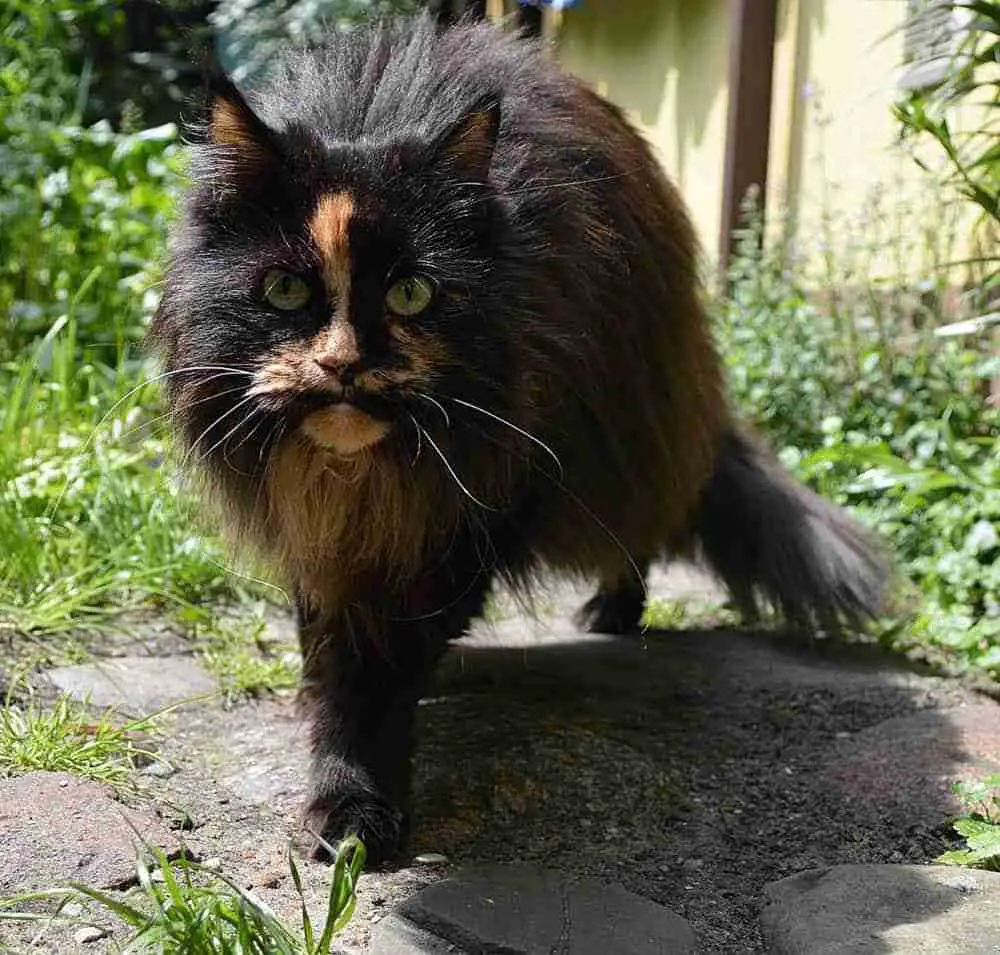Are you a fan of long-haired cats? Want a cat that is a little unusual – maybe even rare? A long hair tortoiseshell cat might be the ideal choice for you! These black and orange cats are not your average tabby! Torties are believed to come with their own distinct personality – fully equipped with tortidude! These distinct long-haired cats with their unique color and special attitude might be the ideal cat for you.
Read on to find out how unusual and special these cats are!
Are Long Hair Tortoiseshell Cats Rare?
The first thing to bear in mind is that long-haired cats are rarer than short hair cats. The long hair gene is recessive.
This means that a cat with two copies of the longhair gene will be long-haired. A cat with one copy will be short-haired but can pass the gene to its offspring. A pair of shorthair cats each carrying the long hair gene may produce a long-haired kitten in a litter. A shorthair cat with no long hair gene will not produce any long-haired offspring.
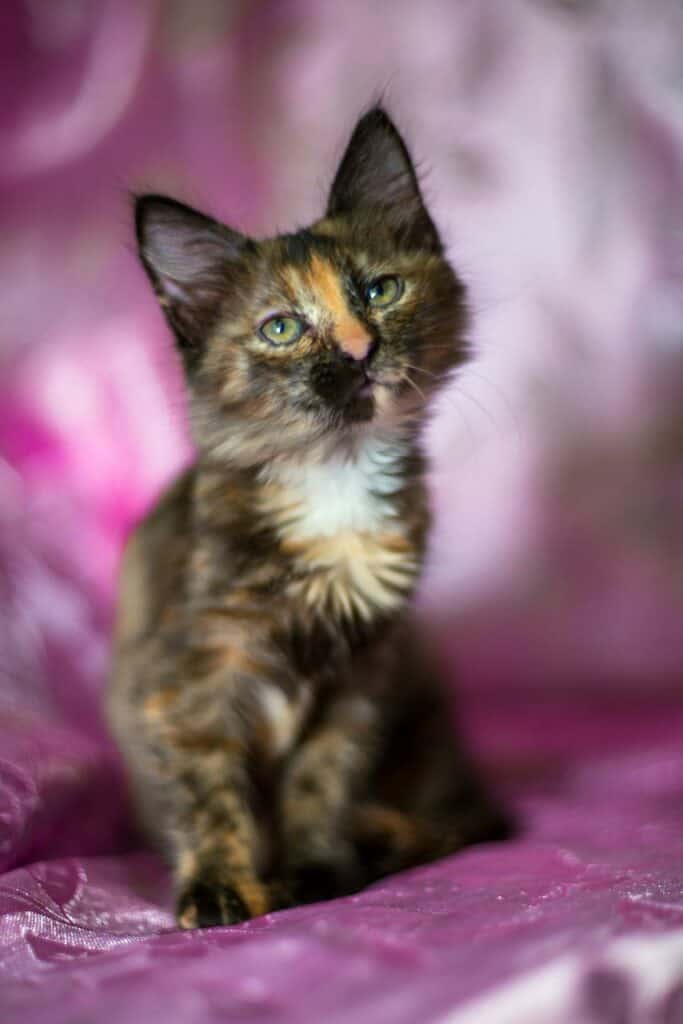
Basically, the fact this gene is recessive means that only 1 in 10 cats is a long hair cat!
In addition to this, tortoiseshell cats are unusual in so much as they exhibit two coat colors, red and black. Coat color is related to sex genes.
A male cat has one X and one Y chromosome. The female cat has two X chromosomes. Coat color genes are carried on the X chromosome, meaning a female cat can carry two of the primary colors for cats, black and red. A male can only carry and exhibit one color at a time.
Other genes contribute to tabby coat patterns, white patches – called piebald and dilution which fades out the red and black to grey, blue, orange, cream hues, etc.
What this means is that, apart from certain genetic mutations, tortie cats are always female!
So, you have long hair cats that only makeup 10% of the cat population, then torties that are nearly always female and female cats only make up 50% of the cat population. This means at best, 5% of the total cat population could be tortie long hair – but this does not take into account calico’s (that have a larger percentage of white on their coat than torties), tabbies of all colors, and every other variation of long hair female cat!
When you consider it, less than 1% of cats are likely to be longhair tortie cats, and don’t even start on the possibility of dilute tortoiseshell variations! So, yes long hair tortoiseshell cats are rare!
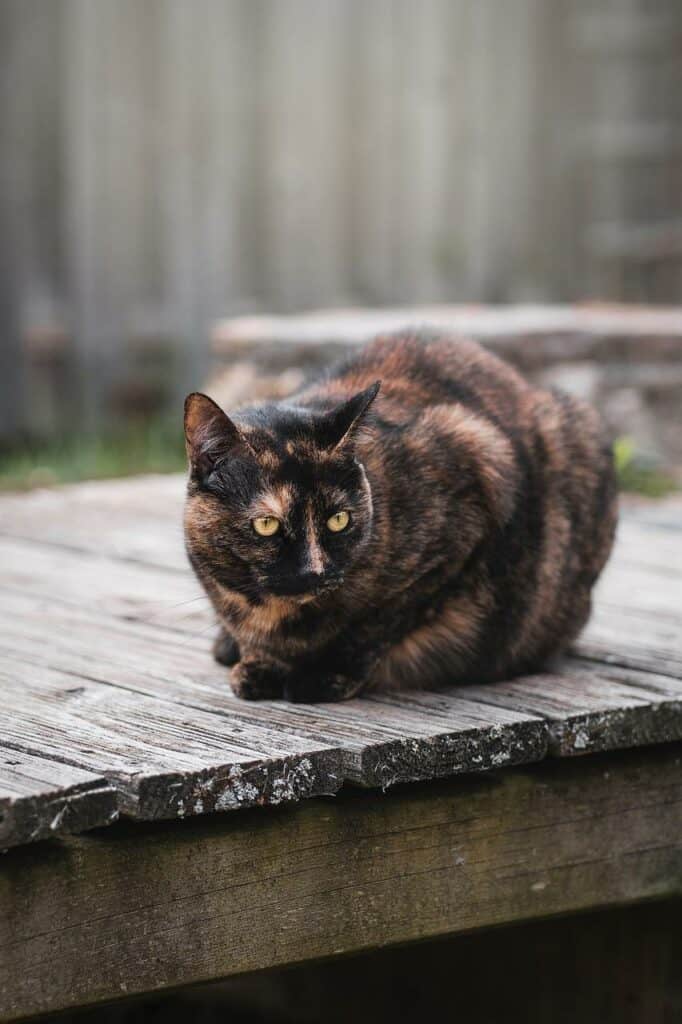
What Breed Is A Long Haired Tortie?
Many people wonder whether torties and long-haired tortoiseshell cats are actually a breed in their own right.
The answer to that is that torties are merely a cat coat color. Specifically, they are orange and black cats. Cats with similar colors but with white making a third color and covering 25 – 75% of the fur are called calico cats.
Neither torties, calico’s, tabby or colorpoint cats are specific breeds – they are descriptions of cat coat colors and patterns!
This means that long hair tortoiseshell cats can turn up in a number of different cat breeds given the right genetics. They also turn up in domestic longhair cats which are cats of mixed breed or indeterminate genetic heritage.
However, bearing in mind the overall rarity of long hair tortoiseshell cats, finding one from a specific breed only makes the odds of success even longer – but they do exist – read on to discover which cat breeds list long hair torties as a recognized breed variation:
6 Popular Long Hair Tortoiseshell Cat Breeds
Here are some of the most popular cat breeds that recognize a longhair tortie as being part of their breed standard. We include domestic longhair cats, even though they are not a breed but a term to describe mixed breed cats, simply because your quest for the 1% is going to be really tough if you want a cat with long hair and tortoiseshell characteristics!
Domestic Longhair Tortie
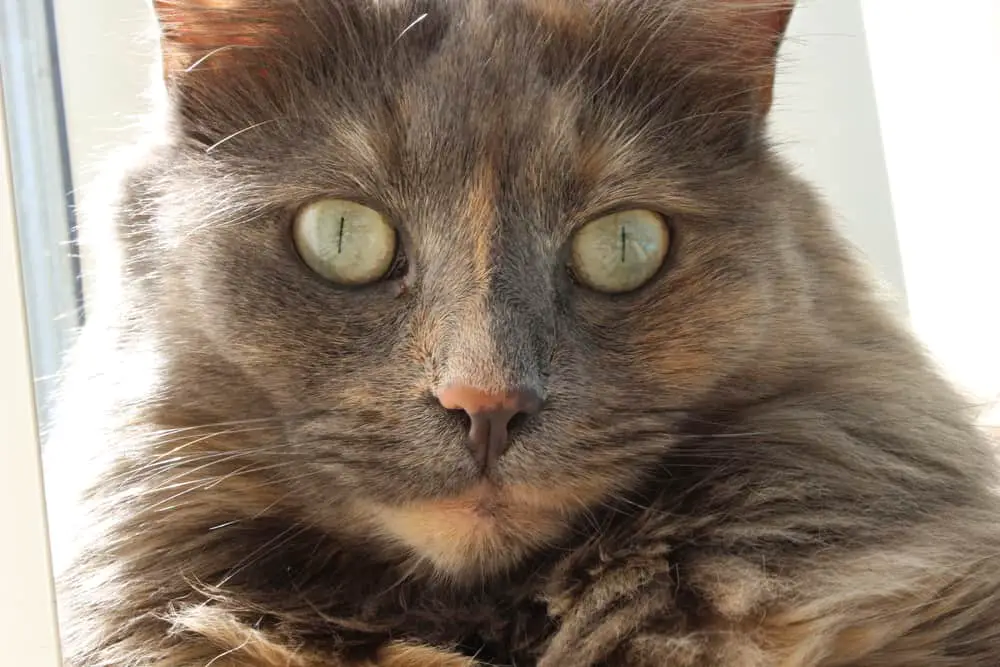
Perhaps your best chance of finding a long hair tortoiseshell cat is to be less choosy and be open to a domestic longhair – a standard mixed breed cat.
They don’t come available often but with a domestic longhair, you know you are going to be getting a healthy cat compared to some purebred cats.
These cats are no different from any other mixed breed cat in terms of lifespan, size, and eye color – but they do, apparently, come with tortitude!
Tortie cats are believed to be a little sassier than other cats and many people put this down to some sort of inherited attitude. It may be that these cats are usually female and therefore slightly smaller, slightly less confident, and more prone to lashing out than bigger, dominant male cats who might be more confident due to their inherent dominance.
But, who knows – as with all domestic long and shorthair cats they come with all sorts of individual personalities and temperaments.
Long Hair Manx Tortoiseshell
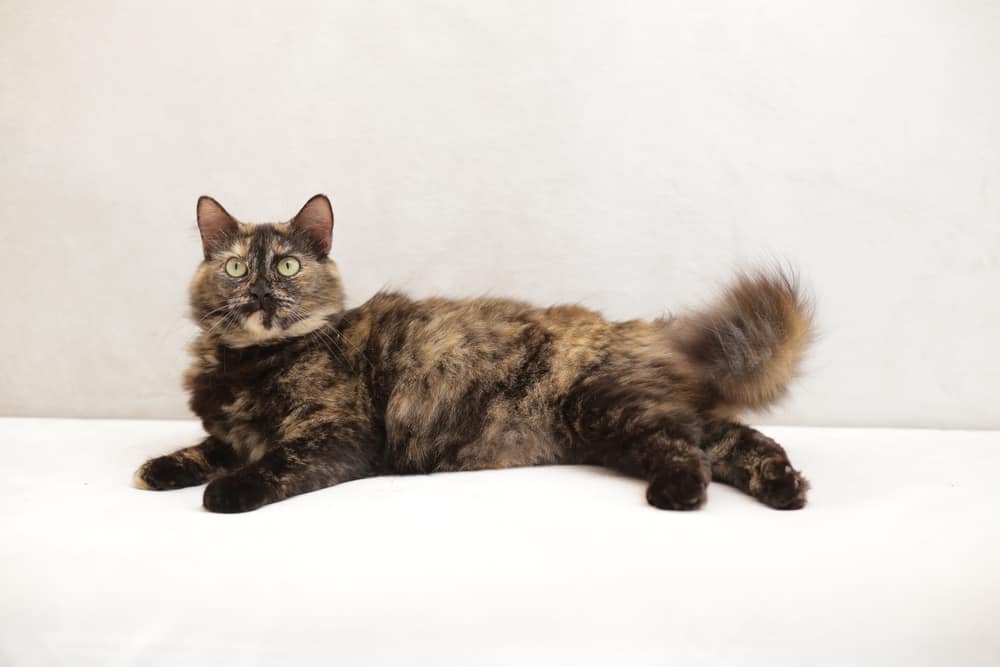
The Manx cat comes in long hair and short hair variations and a multitude of different color and coat patterns that are recognized as being standard for the breed. One such variation is the long hair tortie Manx.
Originating from the Isle of Man, these cats are notably recognizable by their short tails or completely missing tails – a result of a natural genetic mutation. Cats with short tails are stumpy Manx and those with no tails are rumpy Manx cats!
These cats have a reputation for being very effective vermin hunters as well as being loyal spirits who make good family cats. They are not really lap cats but are always hovering around watching and being amongst the household activity.
Maine Coon Tortie
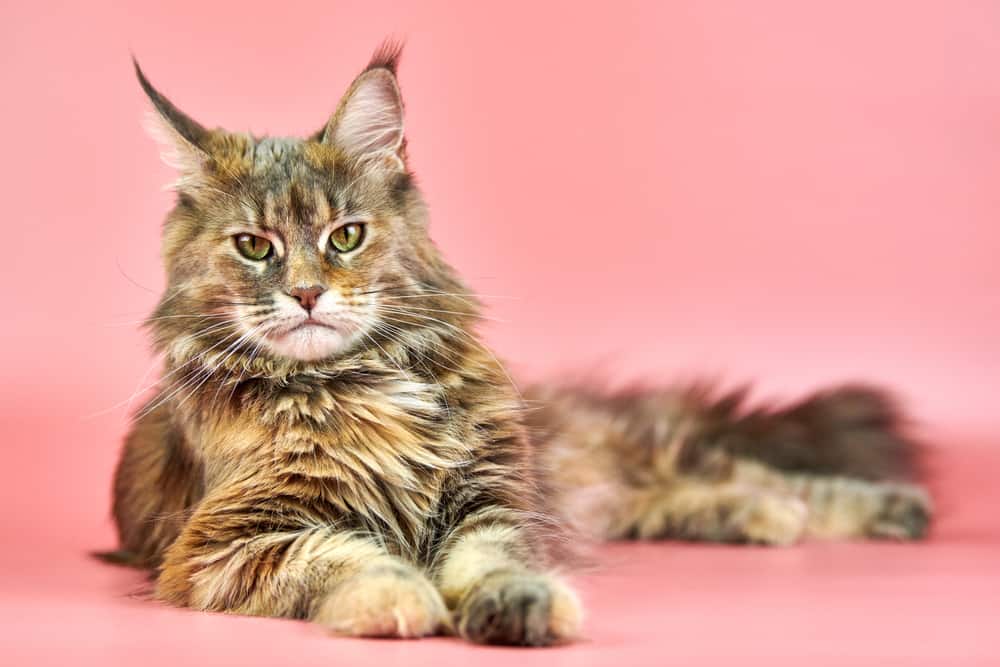
The Maine coon is not strictly a long hair cat or a short hair cat – more of a shaggy cat! But it is the sheer size of these swimming cats that is the stand-out feature.
Many cats develop from kitten to adult cat in a reasonably short time frame of two years – but Maine coons just seem to keep growing and don’t fully mature in size till they are around 5 years old!
They have a full ruff, large pointy ears with instantly recognizable ear tufts, and can be as large as three feet long! They make fine family pets, good with children and other pets.
Available in a range of patterns and colors – the tortie is a recognized breed color and pattern.
British Longhair Tortoiseshell
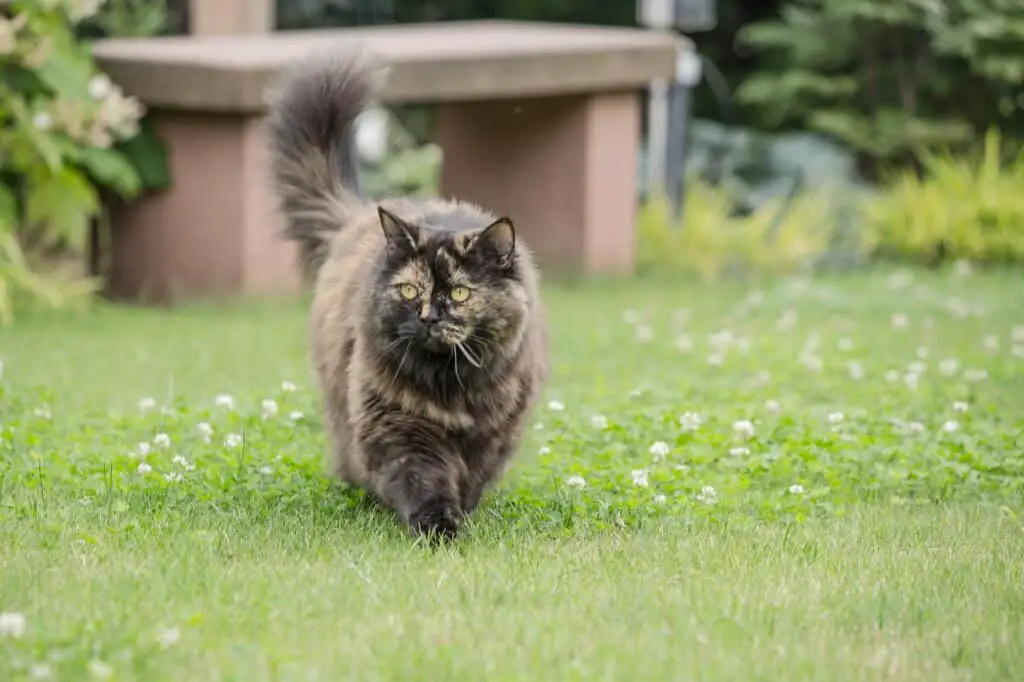
The British longhair is not a breed recognized by all the associations, it is a relatively new breed that is recognized by the gccf.
Basically, this mid-size, long hair cat of medium build is the longhair version of the widely recognized British Shorthair.
The British shorthair has been bred with Turkish Angora and Persian cats at various times in its history to widen the gene pool, and unsurprisingly this has resulted in some longhair offspring carrying those recessive genes.
In the past, these long haired cats were rejected by breeders due to the length of their hair but have become a recognized breed in their own right.
Apart from the robust look associated with their shorthair compadres, they are known to be loyal, family cats that are a little aloof and stand-offish but with a friendly temperament – they are just not so needy as some other cat breeds!
Preferred in blue, they are recognized in a variety of colors and patterns including tortie!
Persian Tortie
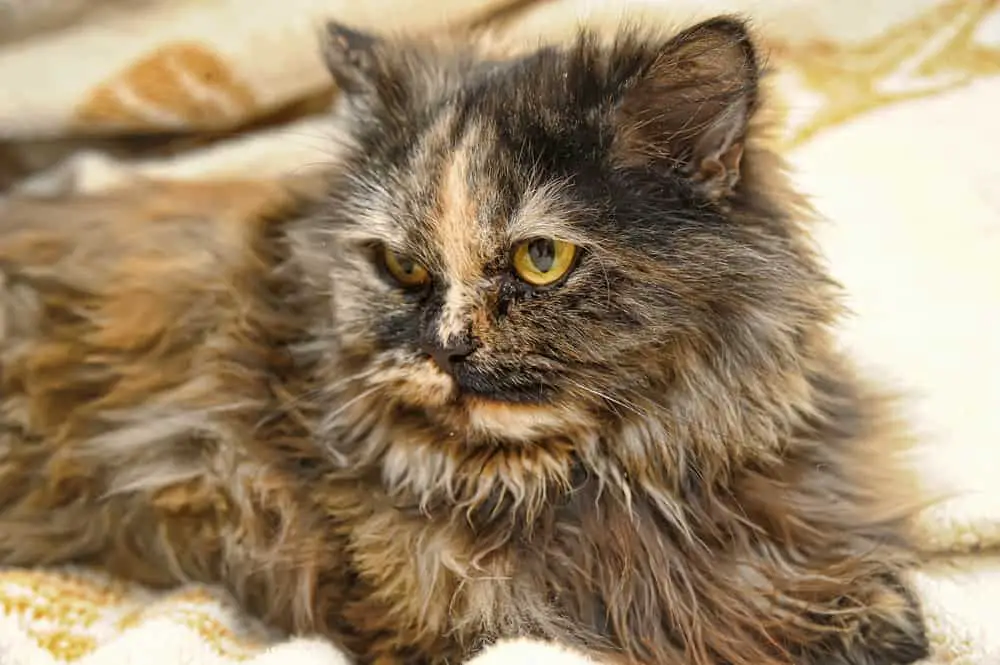
The quintessential long-haired cat is the iconic Persian cat.
Thought to have been around for thousands of years and originating from the area of current-day Iraq, the flat-faced Persian has been one of the de facto most popular cat breeds of all time.
Available in a host of colors and patterns including tortoiseshell, the Persian cat is known to be a laid-back cat that loves to snooze the day away!
They are ground-dwelling cats as opposed to a tree climber and are recognized to be loyal, friendly, but not terribly active!
Their ongoing popularity means there are a decent number of breeders out there so the chances of finding a tortie Persian are probably better than finding a tortie of any other long-haired breed other than that of the Maine coon which is also phenomenally popular.
American Bobtail Tortie
The American Bobtail bears no relation to the Manx or the Japanese bobtail. It is derived as a result of a natural mutation in the local domestic shorthair population and the mutated genes creating the bobtail are different from the mutations found in the other two breeds.
The American bobtail comes in short and long-haired varieties and is a playful, intelligent breed who are recognized as being moderately active.
Their long coat is shaggy rather than silky and long, not unlike the longer fur of a Maine Coon. The tortoiseshell is a recognized breed variant, although finding one in the correct colors may be difficult outside of America due to the regional aspect of the breed.
Long Hair Tortoiseshell Cat Price
Despite only 10% of all cats being long-haired these cats tend to run to similar prices as the more common shorthairs. In part, this may be because there seems to be less of a market for these cats due to the perceived additional maintenance required and potentially because of concerns with shedding.
Generally speaking, locally, a domestic longhair cat in any color is running at $60 whereas pedigree, certified cats of specialist breeds seem to start from $600 and rise to $2500 depending on the perceived breed quality of the cat.
The main problem with acquiring a long hair tortoiseshell cat is not the price but the availability – finding one in the correct colors can be a case of waiting for one to come up in a litter.
